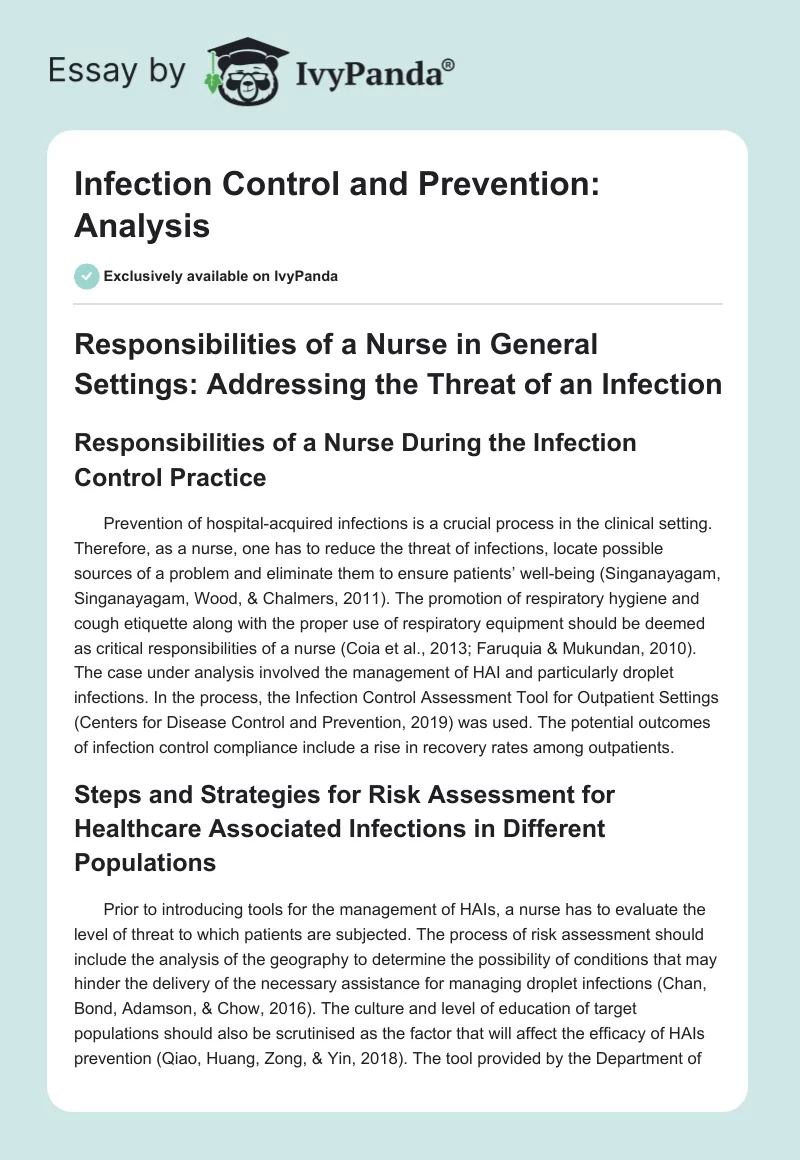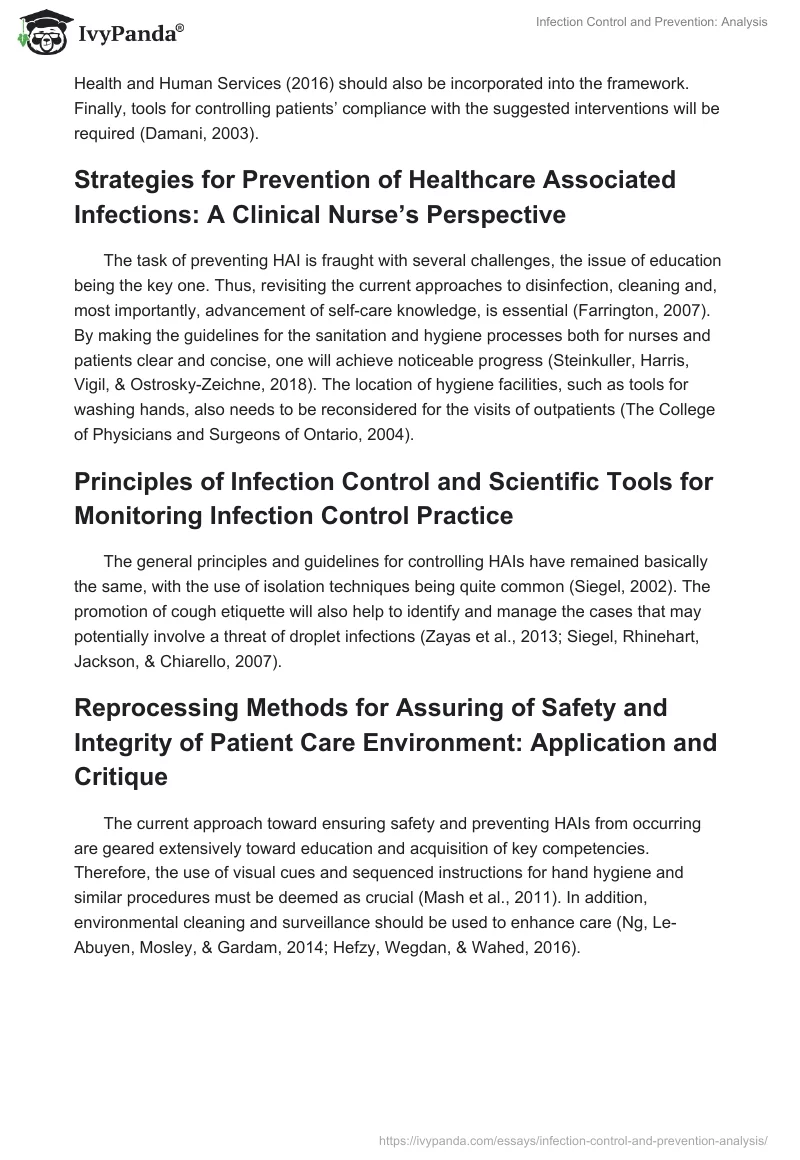Responsibilities of a Nurse in General Settings: Addressing the Threat of an Infection
Responsibilities of a Nurse During the Infection Control Practice
Prevention of hospital-acquired infections is a crucial process in the clinical setting. Therefore, as a nurse, one has to reduce the threat of infections, locate possible sources of a problem and eliminate them to ensure patients’ well-being (Singanayagam, Singanayagam, Wood, & Chalmers, 2011). The promotion of respiratory hygiene and cough etiquette along with the proper use of respiratory equipment should be deemed as critical responsibilities of a nurse (Coia et al., 2013; Faruquia & Mukundan, 2010).
The case under analysis involved the management of HAI and particularly droplet infections. In the process, the Infection Control Assessment Tool for Outpatient Settings (Centers for Disease Control and Prevention, 2019) was used. The potential outcomes of infection control compliance include a rise in recovery rates among outpatients.
Steps and Strategies for Risk Assessment for Healthcare-Associated Infections in Different Populations
Prior to introducing tools for the management of HAIs, a nurse has to evaluate the level of threat to which patients are subjected. The process of risk assessment should include the analysis of the geography to determine the possibility of conditions that may hinder the delivery of the necessary assistance for managing droplet infections (Chan, Bond, Adamson, & Chow, 2016). The culture and level of education of target populations should also be scrutinised as the factor that will affect the efficacy of HAIs prevention (Qiao, Huang, Zong, & Yin, 2018). The tool provided by the Department of Health and Human Services (2016) should also be incorporated into the framework. Finally, tools for controlling patients’ compliance with the suggested interventions will be required (Damani, 2003).
Strategies for Prevention of Healthcare-Associated Infections: A Clinical Nurse’s Perspective
The task of preventing HAI is fraught with several challenges, the issue of education being the key one. Thus, revisiting the current approaches to disinfection, cleaning and, most importantly, advancement of self-care knowledge, is essential (Farrington, 2007). By making the guidelines for the sanitation and hygiene processes both for nurses and patients clear and concise, one will achieve noticeable progress (Steinkuller, Harris, Vigil, & Ostrosky-Zeichne, 2018). The location of hygiene facilities, such as tools for washing hands, also needs to be reconsidered for the visits of outpatients (The College of Physicians and Surgeons of Ontario, 2004).
Principles of Infection Control and Scientific Tools for Monitoring Infection Control Practice
The general principles and guidelines for controlling HAIs have remained basically the same, with the use of isolation techniques being quite common (Siegel, 2002). The promotion of cough etiquette will also help to identify and manage the cases that may potentially involve a threat of droplet infections (Zayas et al., 2013; Siegel, Rhinehart, Jackson, & Chiarello, 2007).
Reprocessing Methods for Assuring of Safety and Integrity of Patient Care Environment: Application and Critique
The current approach toward ensuring safety and preventing HAIs from occurring are geared extensively toward education and the acquisition of key competencies. Therefore, the use of visual cues and sequenced instructions for hand hygiene and similar procedures must be deemed as crucial (Mash et al., 2011). In addition, environmental cleaning and surveillance should be used to enhance care (Ng, Le-Abuyen, Mosley, & Gardam, 2014; Hefzy, Wegdan, & Wahed, 2016).
Reflection on Applying Evidence-Based Practice (EBP) in the Clinical Environment
Description
Managing the needs of influenza (Influenza A virus) patients, especially young ones, is an extraordinarily challenging task (Centers for Disease Control and Prevention, 2019). The case under analysis showed that problems with signage and the lack of compliance with basic hygiene standards such as respiratory hygiene and cough etiquette might lead to serious health complications (Rodrigues, Coelho, & Tavares, 2018).
Feelings
When considering personal impressions of the situation that can be witnessed in the target clinical setting regarding outpatients presently, one is likely to feel rather discouraged due to the lack of resources. The case in question helped to learn the importance of Neuman’s Systems Model as a nursing theory. The fact that signage as one of the crucial aspects of nurse-patient communication is the key cause of failure is very disappointing.
Evaluation
The introduction of patient-friendly signage approaches will help to transfer information within the clinical setting, more effectively (Leonard, Verster, & Coetzee, 2014). The proposed change will help patients to acquire critical self-care skills and ensuring that critical principles of managing HAIs, such as cough etiquette and respiratory hygiene are followed exactly (Rousek & Hallbeck, 2011). Therefore, strategies that will allow shaping the signage process to encourage a better understanding between a nurse and a patient are needed.
Conclusions
The lack of numerous critical components of effective care has defined poor conditions for preventing the acquisition of droplet infections and particularly flu.a. The problem of cough etiquette is one of the main causes of flu.a development in outpatients, yet the issue under analysis is defined by a range of other factors that have been observed in the selected setting (Coia et al., 20213). For example, the lack of training opportunities, the absence of isolation rooms and no defined rules for signage have caused outpatients to become exposed to an array of HAIs, predominantly, flu.a.
Action
The key measures for improving the clinical care band addressing the HAI problem include a multimodal improvement strategy based on the suggestions of the World Health Organisation and several clinical studies (Hashim, Alkaabi, & Bharwani, 2014). One should reconsider instructions that nurses follow when tending to the needs of patients, including the hygiene requirements and the introduction of a patient-friendly signage system (Leonard et al., 2014).
The next and most important step will be altering the current set of principles for promoting change and the improvement of the triage process. Patient and staff education geared toward avoiding potential health hazards and reducing risks should be regarded as the priority (The Centre for Health Protection, 2018). It is also worth considering isolation and similar interventions (Aiello et al., 2016). Thus, the problem of HAIs will be addressed in a proper manner.
References
Aiello, A. E., Simanek, A. M., Eisenberg, M. C., Walsh, A. R., Davis, B., Volz, E.,… Osgood, N. (2016). Design and methods of a social network isolation study for reducing respiratory infection transmission: The eX-FLU cluster randomized trial. Epidemics, 15, 38-55. Web.
The Centre for Health Protection. (2018). Guide to infection control in clinic setting. London, UK: The Centre for Health Protection.
Centers for Disease Control and Prevention. (2019). Influenza (flu). Web.
Chan, W. F., Bond, T. G., Adamson, B., & Chow, M. (2016). Identifying core competencies of infection control nurse specialists in Hong Kong. Clinical Nurse Specialist, 30(1), 1-9. Web.
Coia, J. E., Ritchie, L., Adisesh, A., Booth, C. M., Bradley, C., Bunyan, D.,… Phin, N. (2013). Guidance on the use of respiratory and facial protection equipment. Journal of Hospital Infection, 85(3), 170-182. Web.
The College of Physicians and Surgeons of Ontario. (2004). Infection control in the physician’s office. Vancouver, Canada: BC Centre for Disease Control.
The Department of Health and Human Services. (2016). Infection prevention and control assessment tool for outpatient settings. Washington, DC: Centers for Disease Control and Prevention.
Damani, N. N. (2003). Manual of infection control procedures (2nd ed.). Cambridge, UK: CUP.
Farrington, M. (2007). Infection control education: How to make an impact – Tools for the job. Journal of Hospital Infection, 65, 128-132. Web.
Faruqui, F., & Mukundan, D. (2010). 2009 pandemic influenza: A review. Current Opinion in Pediatrics, 22(4), 530-535.
Hashim, M. J., Alkaabi, M. S. K. M., & Bharwani, S. (2014). Interpretation of way-finding healthcare symbols by a multicultural population: Navigation signage design for global health. Applied Ergonomics, 45(3), 503-509. Web.
Hefzy, E. M., Wegdan, A. A., & Wahed, W. Y. (2016). Hospital outpatient clinics as a potential hazard for healthcare associated infections. Journal of Infection and Public Health, 9(1), 88-97. Web.
Leonard, A. L., Verster, A., & Coetzee, M. (2014). Developing family-friendly signage in a South African paediatric healthcare setting. Curationis, 37(2), 1-7. Web.
Mash, C., Baker, J., Foster, C., & Goldfarb, J. (2011). Improved infection control compliance using isolation signs that incorporate standardized colors, visual cues, and sequenced instructions. American Journal of Infection Control, 39(5), 445-447. Web.
Ng, J., Le-Abuyen, S., Mosley, J., & Gardam, M. (2014). A pragmatic approach to infection prevention and control guidelines in an ambulatory care setting. American Journal of Infection Control, 42(6), 671-673. Web.
Qiao, F., Huang, W., Zong, Z., & Yin, W. (2018). Infection prevention and control in outpatient settings in China – Structure, resources, and basic practices. American Journal of Infection Control, 46(7), 802-807. Web.
Rodrigues, R., Coelho, R., & Tavares, J. M. R. (2018). Healthcare signage design: A review on recommendations for effective signing systems. HERD: Health Environments Research & Design Journal, 1(1), 1-12. Web.
Rousek, J. B., & Hallbeck, M. S. (2011). Improving and analyzing signage within a healthcare setting. Applied Ergonomics, 42(6), 771-784. Web.
Siegel, J. D. (2002). Controversies in isolation and general infection control practices in pediatrics. Seminars in Pediatric Infectious Diseases, 13(1), 48-54.
Siegel, J. D., Rhinehart, E., Jackson, M., & Chiarello, L. (2007). 2007 Guideline for isolation precautions preventing transmission of infectious agents in healthcare settings. Washington, DC: CDC.
Singanayagam, A., Singanayagam, A., Wood, V., & Chalmers, J. D. (2011). Factors associated with severe illness in pandemic 2009 influenza a (H1N1) infection: Implications for triage in primary and secondary care. Journal of Infection, 63(4), 243-251. Web.
Steinkuller, F., Harris, K., Vigil, K. J., & Ostrosky-Zeichner, L. (2018). Outpatient infection prevention: A practical primer. Open Forum Infectious Diseases, 5(5), 53-60. Web.
Zayas, G., Chiang, M. C., Wong, E., Macdonald, F., Lange, C. F., Senthilselvan, A., & King, M. (2013). Effectiveness of cough etiquette maneuvers in disrupting the chain of transmission of infectious respiratory diseases. BMC Public Health, 13(1), 811-823. Web.


